Microclimate of the Natural History Museum, Vienna
Abstract
1. Introduction
2. Materials and Methods
2.1. The Natural History Museum in Vienna
2.2. Instrumentation and Data
2.3. Data Analysis and Statistics
3. Results and Discussion
3.1. Building Microclimate
3.1.1. Floors of the Building
3.1.2. Areas of the Building
3.2. Indoor Climate Cycles
3.2.1. Zoological Library
3.2.2. Diurnal Patterns in the Exhibition Halls
3.3. Microclimates in Specific Parts of the Building
3.4. Floor-Level Microclimate
3.5. Long Term Change
3.5.1. Long Term Change in the Cold Store
3.5.2. Long Term Change in the Hall of Primates
3.6. Managing the Museum Climate
4. Conclusions
Author Contributions
Funding
Data Availability Statement
Conflicts of Interest
References
- Lucchi, E. Review of preventive conservation in museum buildings. J. Cult. Herit. 2018, 29, 180–193. [Google Scholar]
- Thomson, G. Museum Environment; Routledge: Abingdon, UK, 2018. [Google Scholar]
- Camuffo, D. Microclimate for Cultural Heritage: Measurement, Risk Assessment, Conservation, Restoration, and Maintenance of Indoor and Outdoor Monuments; Elsevier: Amsterdam, The Netherlands, 1998. [Google Scholar]
- Sharif-Askari, H.; Abu-Hijleh, B. Review of museums’ indoor environment conditions studies and guidelines and their impact on the museums’ artifacts and energy consumption. Build. Environ. 2018, 143, 186–195. [Google Scholar] [CrossRef]
- Elkadi, H.; Al-Maiyah, S.; Fielder, K.; Kenawy, I.; Martinson, D.B. The regulations and reality of indoor environmental standards for objects and visitors in museums. Renew. Sust. Energ. Rev. 2021, 152, 111653. [Google Scholar] [CrossRef]
- Ferdyn-Grygierek, J. Monitoring of indoor air parameters in large museum exhibition halls with and without air-conditioning systems. Build. Environ. 2016, 107, 113–126. [Google Scholar]
- Sciurpi, F.; Carletti, C.; Cellai, G.; Pierangioli, L. Environmental monitoring and microclimatic control strategies in “La Specola” museum of Florence. Energy Build. 2015, 95, 190–201. [Google Scholar]
- Corbellini, S.; Di Francia, E.; Grassini, S.; Iannucci, L.; Lombardo, L.; Parvis, M. Cloud based sensor network for environmental monitoring. Measurement 2018, 118, 354–361. [Google Scholar] [CrossRef]
- Brimblecombe, P. The composition of museum air. Atmos. Environ. 1990, 24B, 1–8. [Google Scholar]
- Leissner, J.; Kilian, R.; Kotova, L.; Jacob, D.; Mikolajewicz, U.; Broström, T.; Ashley-Smith, J.; Schellen, H.L.; Martens, M.; van Sabbioni, C.; et al. Global Climate Change Impact on Built Heritage and Cultural Landscapes. In Proceedings of the International Conference on Heritage, Weathering and Conservation, HWC, Madrid, Spain, 21–24 June 2006; pp. 395–401. [Google Scholar]
- Brimblecombe, P.; Richards, J. Applied climatology for heritage. Theor. Appl. Climatol. 2024, 155, 7325–7333. [Google Scholar]
- Ankersmit, B.; Stappers, M.H. Managing Indoor Climate Risks in Museums; Springer International Publishing: Cham, Switzerland, 2017. [Google Scholar]
- Lankester, P.; Brimblecombe, P. Future thermohygrometric climate within historic houses. J. Cult. Herit. 2012, 13, 1–6. [Google Scholar]
- Salah Bakry, M.; Hamdy, M.; Mohamed, A.; Elsayed, K. Energy saving potential in open museum spaces: A comparative hygrothermal microclimates analysis. Build. Environ. 2022, 225, 10963. [Google Scholar]
- ElAdl, M.; Fathy, F.; Morsi, N.K.; Nessim, A.; Refat, M.; Sabry, H. Managing microclimate challenges for museum buildings in Egypt. Ain Shams Eng. J. 2022, 13, 101529. [Google Scholar]
- Litti, G.; Audenaert, A. An integrated approach for indoor microclimate diagnosis of heritage and museum buildings: The main exhibition hall of Vleeshuis museum in Antwerp. Energy Build. 2018, 162, 91–108. [Google Scholar]
- Litti, G.; Audenaert, A.; Fabbri, K. Indoor Microclimate Quality (IMQ) certification in heritage and museum buildings: The case study of Vleeshuis museum in Antwerp. Build. Environ. 2017, 124, 478–491. [Google Scholar]
- Schito, E.; Testi, D. Integrated maps of risk assessment and minimization of multiple risks for artworks in museum environments based on microclimate control. Build. Environ. 2017, 123, 585–600. [Google Scholar]
- Ferdyn-Grygierek, J.; Grygierek, K. HVAC control methods for drastically improved hygrothermal museum microclimates in warm season. Build. Environ. 2019, 149, 90–99. [Google Scholar]
- Waller, R. Conservation risk assessment: A strategy for managing resources for preventive conservation. Stud. Conserv. 1994, 39 (Suppl. 2), 12–16. [Google Scholar]
- Waller, R. Risk management applied to preventive conservation. In Storage of Natural History Collections: A Preventive Conservation Approach; Society for the Preservation of Natural History Collections: Washington, DC, USA, 1995; pp. 21–28. [Google Scholar]
- Waller, R. Fundamental requirements for historic house preservation risk management. In Preventive Conservation in Historic Houses and Palace Museums: Assessment Methodologies and Applications; Silvana Editoriale S.p.A.: Cinisello Balsamo (Milan), Italy, 2019. [Google Scholar]
- Muething, G.; Waller, R.; Graham, F. Risk Assessment of Collections in Exhibitions at the Canadian Museum of Nature. J. Amer. Ins. Cons. 2005, 44, 233–243. [Google Scholar]
- Brimblecombe, P.; Lankester, P. Long-term changes in climate and insect damage in historic houses. Stud. Conserv. 2013, 58, 13–22. [Google Scholar]
- Hansen, L.S.; Åkerlund, M.; Grøntoft, T.; Ryhl-Svendsen, M.; Schmidt, A.L.; Bergh, J.-E.; Jensen, K.-M.V. Future pest status of an insect pest in museums, Attagenus smirnovi: Distribution and food consumption in relation to climate change. J. Cult. Herit. 2012, 13, 22–27. [Google Scholar]
- Querner, P.; Sterflinger, K.; Derksen, K.; Leissner, J.; Landsberger, B.; Hammer, A.; Brimblecombe, P. Climate change and its effects on indoor pests (insect and Fungi) in museums. Climate 2022, 10, 103. [Google Scholar] [CrossRef]
- Brimblecombe, P.; Grossi, C.M.; Harris, I. Climate change critical to cultural heritage. In Survival and Sustainability: Environmental Concerns in the 21st Century; Springer: Berlin/Heidelberg, Germany, 2011; pp. 195–205. [Google Scholar]
- Querner, P. Modelling Museum Pests–Insects and Fungi–and Climate Change. Available online: https://nhm-wien.ac.at/en/research/interdepartmental_projects/modelling_museum_pests_ (accessed on 8 March 2025).
- Koeberl, C.; Brandstätter, F.; Harzhauser, M.; Riedl-Dorn, C. History and importance of the geoscience collections at the Natural History Museum Vienna. In Museums at the Forefront of the History and Philosophy of Geology: History Made, History in the Making; Rosenberg, G.D., Clary, R.M., Eds.; The Geological Society of America: Boulder, CO, USA, 2018. [Google Scholar] [CrossRef]
- Jovanovic-Kruspel, S.; Schumacher, A. Das Naturhistorische Museum—Baugeschichte, Konzeption & Architektur; Naturhistorisches Museum: Vienna, Austria, 2014. [Google Scholar]
- Clemenzi, R. Water Vapor—Other Formulas. Available online: http://mc-computing.com/Science_Facts/Water_Vapor/Other_Formulas.html (accessed on 18 February 2025).
- Zentralanstalt für Meteorologie und Geodynamik. Available online: https://www.zamg.ac.at/cms/de/aktuell (accessed on 8 March 2025).
- Vassarstats. Available online: https://www.vassarstats.net/ (accessed on 8 March 2025).
- Theil-Sen Slopes Applied as an Outlier-Resistant Alternative to the Linear Regression Slope from Single Case Research. Available online: https://singlecaseresearch.org/calculators/theil-sen (accessed on 8 March 2025).
- Wessa, P. Decomposition by Loess (v1.0.3) in Free Statistics Software (v1.2.1), Office for Research Development and Education. 2021. Available online: http://www.wessa.net/rwasp_decomposeloess.wasp/ (accessed on 8 March 2025).
- Fallahnejad, M.; Hartner, M.; Kranzl, L.; Fritz, S. Impact of distribution and transmission investment costs of district heating systems on district heating potential. Energy Procedia 2018, 149, 141–150. [Google Scholar]
- Büchele, R.; Kranzl, L.; Müller, A.; Hummel, M.; Hartner, M.; Deng, Y.; Bons, M. Comprehensive assessment of the potential for efficient district heating and cooling and for high-efficient cogeneration in Austria. Int. J. Sustain. Energy Plann. Manag. 2016, 10, 3–20. [Google Scholar]
- Brimblecombe, P.; Sterflinger, K.; Derksen, K.; Haltrich, M.; Querner, P. Thermohygrometric climate, insects and fungi in the Klosterneuburg Monastic Library. Heritage 2022, 5, 4228–4244. [Google Scholar] [CrossRef]
- Bernardi, A. Microclimate in the British museum, London. Mus. Manag. Curatorship 1990, 9, 169–182. [Google Scholar]
- Kumar, P.; Wright, B.; Petsou, A. Overheating in Historic Buildings in the UK: An Exploratory Study of Overheating Risks, Building Performance, and Thermal Comfort. Heritage 2024, 7, 4829–4854. [Google Scholar] [CrossRef]
- Sturaro, G.; Camuffo, D.; Brimblecombe, P.; Van Grieken, R.; Busse, H.J.; Bernardi, A.; Valentino, A.; Blades, N.; Gysels, K.; Deutsch, F.; et al. Multidisciplinary environmental monitoring at the Kunsthistorisches Museum, Vienna. J. Trace Microprobe Tech. 2003, 21, 273–294. [Google Scholar] [CrossRef]
- Camuffo, D.; Van Grieken, R.; Busse, H.J.; Sturaro, G.; Valentino, A.; Bernardi, A.; Blades, N.; Shooter, D.; Gysels, K.; Deutsch, F.; et al. Environmental monitoring in four European museums. Atmos. Environ. 2001, 35, 127–140. [Google Scholar] [CrossRef]
- Huber, A. Ökosystem Museum. Grundlagen zu Einem Konservatorischen Betriebskonzept für die Neue Burg in Wien. Ph.D. Thesis, Academy of Fine Arts, Vienna, Austria, 2011. (In German). [Google Scholar]
- Frasca, F.; Siani, A.M.; Bertolin, C. Energy demand for indoor climate control in museums: Challenges and perspectives in time of a changing climate. Procedia Struct. Integr. 2024, 55, 32–38. [Google Scholar]
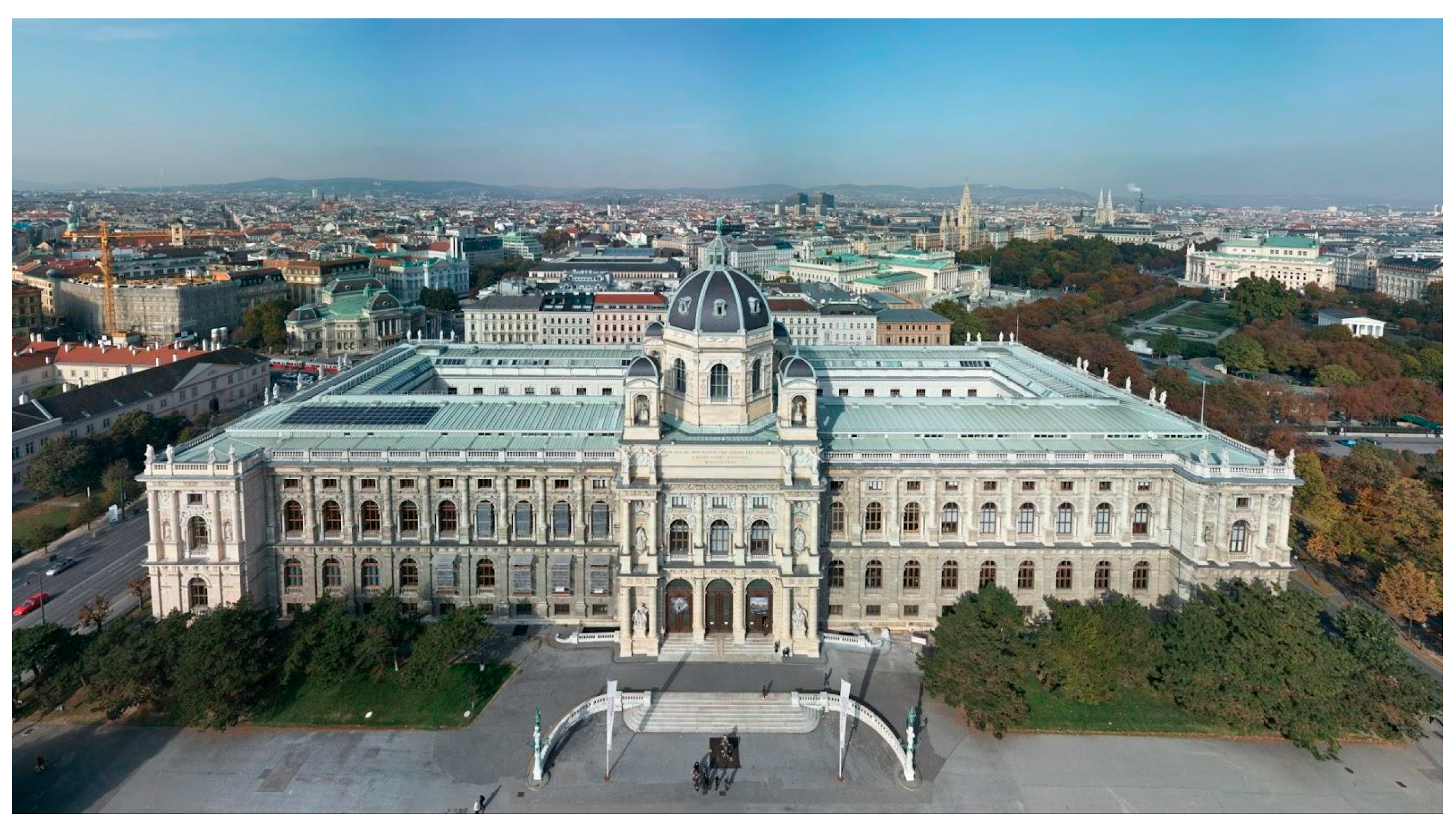
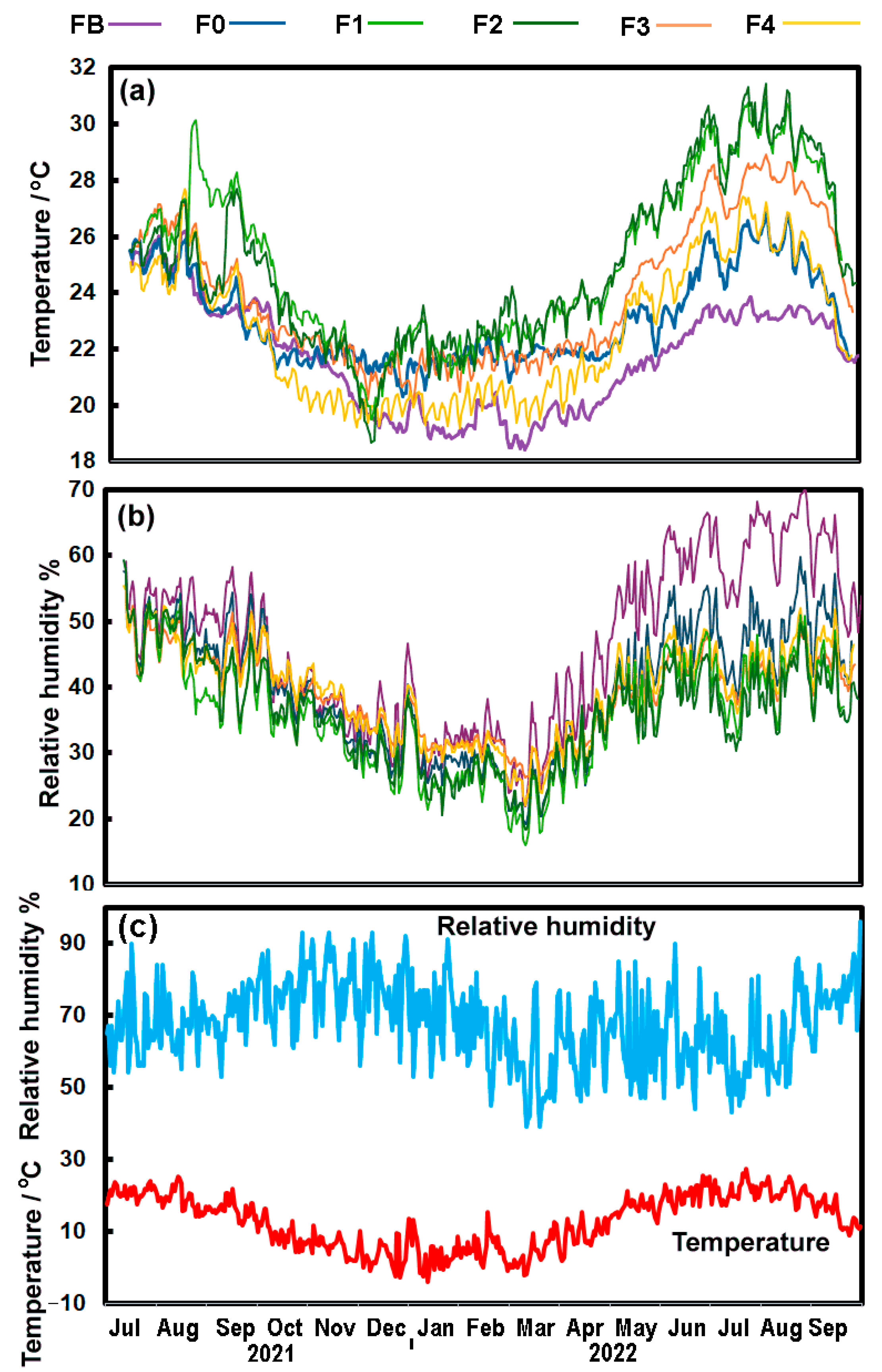
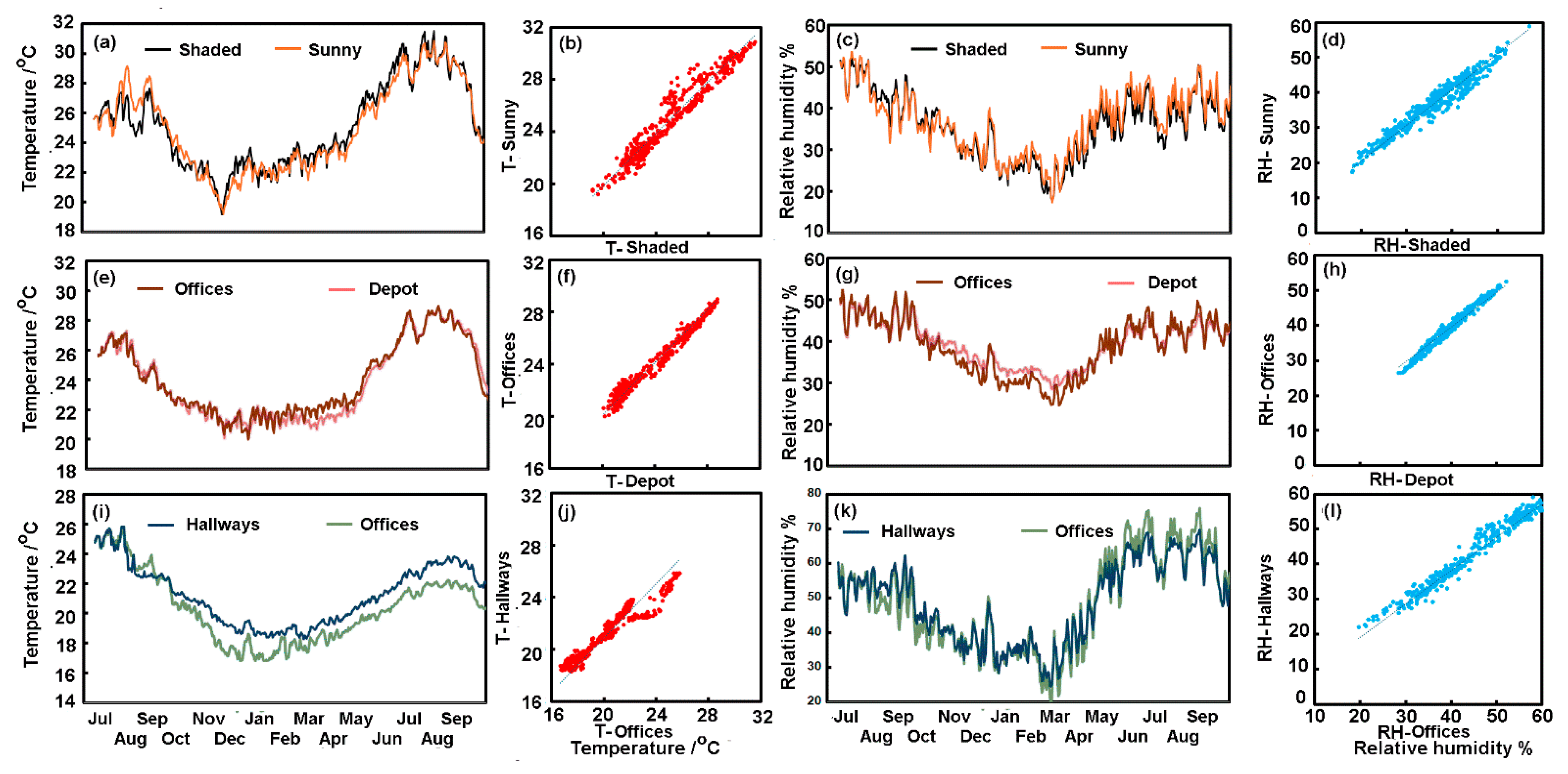



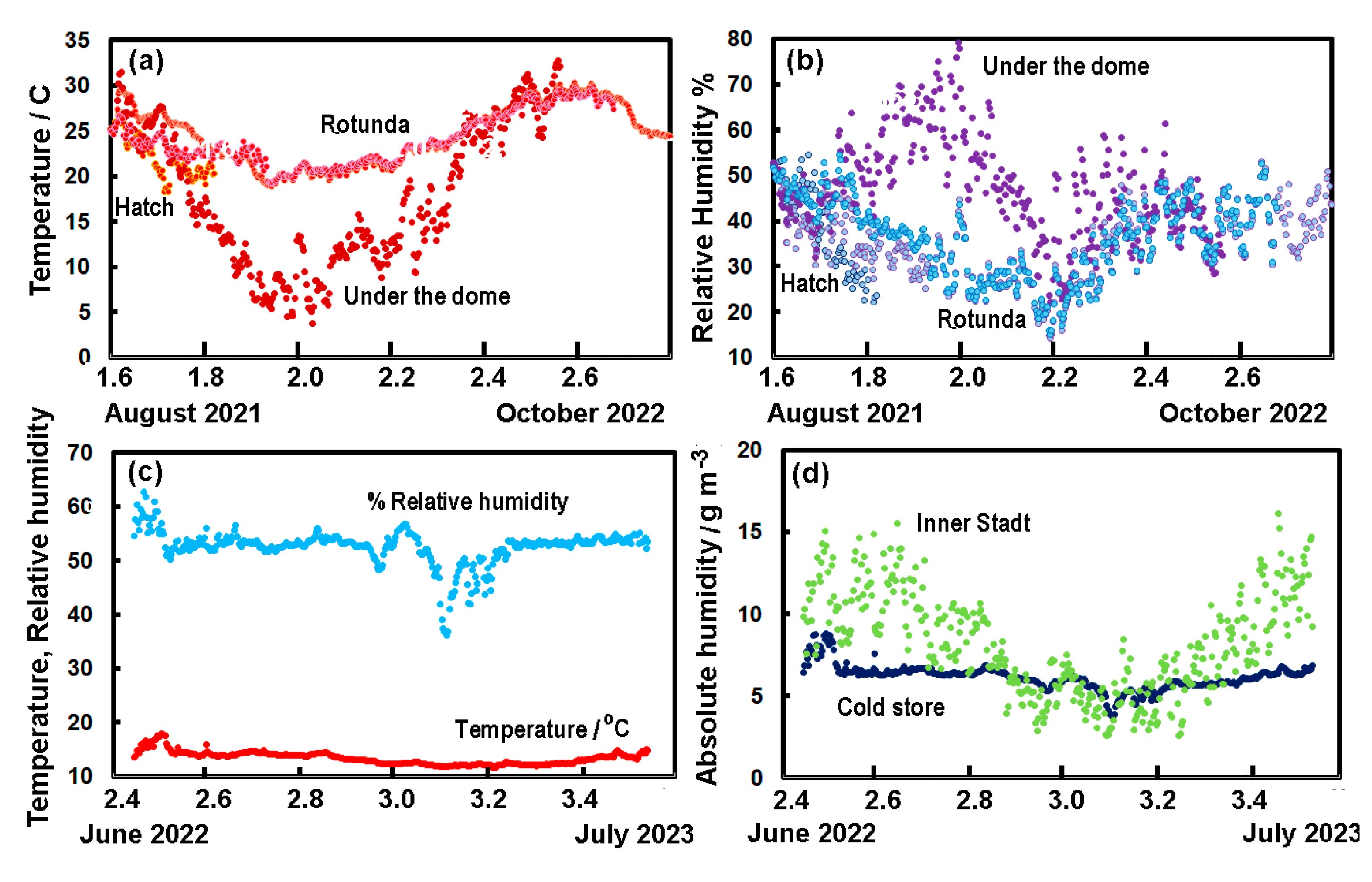
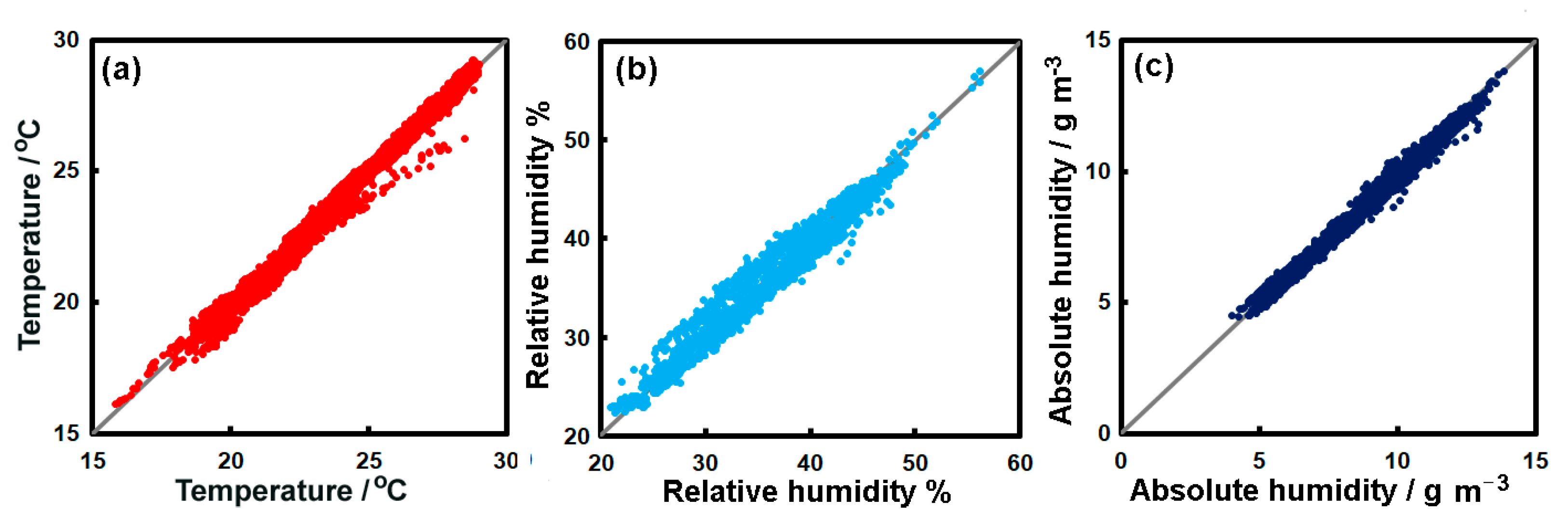


| Floor No | Description | Floor Code | Collection Type and Room Use | Climate Control | Data Loggers | Data Loggers in Contact with Floor | Public Access | Open Windows Natural Ventilation |
|---|---|---|---|---|---|---|---|---|
| F4 | Attic, modern | OG3 | archive, library, botany, entomology, offices | HVAC | 37 | 4 | no | no |
| F3 | historic | OG2 | mammal, library, entomology, anthropology, botany | only heating | 42 | 5 | no | partly |
| F2 | historic | OG1 | exhibition, bird, library | only heating | 44 | 5 | yes | yes |
| F1 | Mezzanine historic | HP | exhibition, offices | only heating | 36 | 5 | yes | yes |
| F0 | Ground floor, historic | TP+EG | library, taxidermy studio, offices | only heating | 40 | 0 | no | no |
| FB | Basement, historic | K | technical rooms, storage | no control | 32 | 0 | no | no |
| FC | Cooled storage, modern | storage | HVAC | 5 | 0 | no | no |
| Floor | Temperature °C | Relative Humidity % |
|---|---|---|
| F4 | 22.2 ± 2.4 | 38.1 ± 6.8 |
| F3 | 24.5 ± 2.3 | 37.9 ± 6.1 |
| F2 | 23.4 ± 2.8 | 34.5 ± 7.4 |
| F1 | 24.8 ± 2.9 | 34.1 ± 7.9 |
| F0 | 22.7 ± 1.5 | 38.0 ± 9.4 |
| FB | 21.3 ± 1.8 | 43.9 ± 11.8 |
Disclaimer/Publisher’s Note: The statements, opinions and data contained in all publications are solely those of the individual author(s) and contributor(s) and not of MDPI and/or the editor(s). MDPI and/or the editor(s) disclaim responsibility for any injury to people or property resulting from any ideas, methods, instructions or products referred to in the content. |
© 2025 by the authors. Licensee MDPI, Basel, Switzerland. This article is an open access article distributed under the terms and conditions of the Creative Commons Attribution (CC BY) license (https://creativecommons.org/licenses/by/4.0/).
Share and Cite
Brimblecombe, P.; Bibl, A.; Fischer, C.; Pristacz, H.; Querner, P. Microclimate of the Natural History Museum, Vienna. Heritage 2025, 8, 124. https://doi.org/10.3390/heritage8040124
Brimblecombe P, Bibl A, Fischer C, Pristacz H, Querner P. Microclimate of the Natural History Museum, Vienna. Heritage. 2025; 8(4):124. https://doi.org/10.3390/heritage8040124
Chicago/Turabian StyleBrimblecombe, Peter, Alexander Bibl, Christian Fischer, Helmut Pristacz, and Pascal Querner. 2025. "Microclimate of the Natural History Museum, Vienna" Heritage 8, no. 4: 124. https://doi.org/10.3390/heritage8040124
APA StyleBrimblecombe, P., Bibl, A., Fischer, C., Pristacz, H., & Querner, P. (2025). Microclimate of the Natural History Museum, Vienna. Heritage, 8(4), 124. https://doi.org/10.3390/heritage8040124







